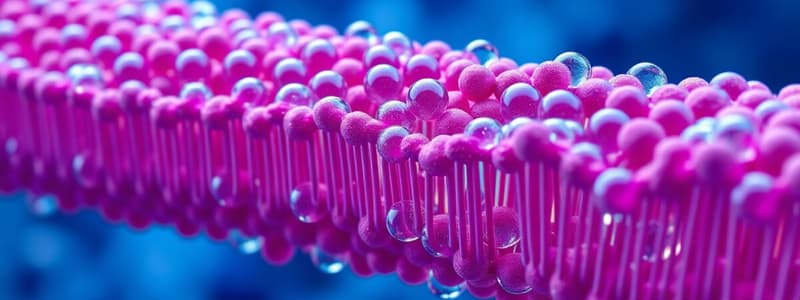Podcast
Questions and Answers
What is the common property that all lipids share?
What is the common property that all lipids share?
The common property that all lipids share is being relatively insoluble in water and soluble in nonpolar solvents such as ether and chloroform.
Which of the following are classified as lipids? (Select all that apply)
Which of the following are classified as lipids? (Select all that apply)
- Proteins
- Oils (correct)
- Carbohydrates
- Fats (correct)
- Steroids (correct)
- Waxes (correct)
What is the primary function of lipids in the body?
What is the primary function of lipids in the body?
- Transporting oxygen
- Building muscle tissue
- Regulating blood sugar
- Providing energy (correct)
What are the two main categories of lipids based on their chemical composition?
What are the two main categories of lipids based on their chemical composition?
What are the two main types of fatty acids?
What are the two main types of fatty acids?
What are essential fatty acids, and why are they important?
What are essential fatty acids, and why are they important?
What is the main reason why high levels of cholesterol are considered a risk factor for heart disease?
What is the main reason why high levels of cholesterol are considered a risk factor for heart disease?
What are some common examples of foods that are rich in omega-3 fatty acids?
What are some common examples of foods that are rich in omega-3 fatty acids?
Prostaglandins are produced only in the prostate gland.
Prostaglandins are produced only in the prostate gland.
Obesity, atherosclerosis, diabetes mellitus, hyperlipoproteinemia, and fatty liver are all diseases linked to abnormal lipid metabolism or chemistry.
Obesity, atherosclerosis, diabetes mellitus, hyperlipoproteinemia, and fatty liver are all diseases linked to abnormal lipid metabolism or chemistry.
Which of the following is NOT a clinical importance of essential fatty acids?
Which of the following is NOT a clinical importance of essential fatty acids?
Flashcards
Lipid classification
Lipid classification
Lipids are categorized based on their chemical composition (simple, compound, derived) and sources (visible, invisible).
Simple lipids
Simple lipids
Simple lipids are esters of fatty acids and glycerol (e.g., fats and oils), or esters of fatty acids and long-chain alcohols (e.g., waxes).
Compound lipids (Phospholipids)
Compound lipids (Phospholipids)
Compound lipids contain lipid components and non-lipid components like phosphoric acid and nitrogenous bases (e.g., lecithin, cephalin).
Derived lipids
Derived lipids
Signup and view all the flashcards
Lipid functions
Lipid functions
Signup and view all the flashcards
Essential fatty acids
Essential fatty acids
Signup and view all the flashcards
Eicosanoids
Eicosanoids
Signup and view all the flashcards
Prostaglandins
Prostaglandins
Signup and view all the flashcards
Study Notes
Lecture 28: Chemistry and Functions of Lipids
- Lipids are a diverse group of compounds including fats, oils, steroids, waxes and related compounds.
- They are mainly characterized by their physical properties rather than chemical ones.
- Lipids are largely insoluble in water but soluble in nonpolar solvents like ether and chloroform.
Objectives
- Discuss the classification of lipids, fatty acids, phospholipids, triacylglycerols, cholesterol, and prostaglandins, and their biochemical actions.
Introduction
- Lipids have various functions, including being an energy source, creating a protective barrier, and acting as electrical insulation.
- Lipids are important components of cell membranes.
Functions of Lipids
- Energy source: Stored as triglycerides in adipose tissue.
- Metabolic functions: Protect organs.
- Structural component: Provide structural integrity.
- Protective barrier: Provide insulation.
- Electrical insulation: Myelin sheath surrounding nerve cells.
- Cushioning effects: Protect organs from shock.
- Positioning of organs: Crucial for organ placement.
- Formation of lipid bilayer: Essential for cell membranes.
- Prevent drying: Protect surfaces from drying out.
- Thermal insulation: Keep the body warm.
Biochemical Functions of Lipids
- Storage of energy: Triglycerides stored in adipose tissue.
- Structural components of biomembranes: Phospholipids and cholesterol.
- Metabolic regulators: Steroid hormones and prostaglandins.
- Surfactants, detergents and emulsifying agents: Amphipathic lipids.
- Molecules containing both hydrophobic and hydrophilic groups.
- Orient at oil-water interfaces with polar groups facing water and nonpolar groups facing oil.
- Electrical insulators: Lipids such as myelin insulate nerve cell axons.
Classification of Lipids
- Lipids are classified into 4 categories:
- Chemical composition (simple, complex, derived, miscellaneous)
- Fatty acids
- Requirements (essential/non-essential)
- Sources (visible/invisible)
- Lipids are further categorized into simple, compound and derived lipids.
Simple Lipids
- Fats and Oils: Esters of fatty acids and glycerol (also known as triglycerides). These constitute a major portion of dietary lipid and body fats (98-99%).
- Waxes: Esters formed from long-chain fatty acids and long-chain alcohols. They protect plants from dehydration and invasion by microorganisms.
Compound Lipids
- Phospholipids: Contain phosphoric acid and a nitrogenous base in addition to fatty acids and glycerol. Examples include lecithin and cephalin. Abundant in brain & nerve tissues.
- Glycolipids: Complex lipids containing carbohydrates in combination with fatty acids and glycerol. Examples include cerebrosides.
- Sulfolipids: Possess a sulfur-containing functional group and are found in photosynthetic organisms.
- Lipoproteins: Carriers of lipids in the blood, involved in cell membrane formation. Examples include LDL and HDL.
Derived Lipids
- Sterols: Solid alcohols that form esters with fatty acids. Cholesterol is a crucial waxy, fat-like substance found in all cells; synthesized by the liver and acts as a precursor for steroid hormones, Vitamin D and bile.
- Fatty Acids: Key building blocks and energy sources for cells. Classified as saturated/unsaturated. Examples include oleic, linoleic, and linolenic acids.
Eicosanoids
- These molecules are derived from 20-carbon polyunsaturated fatty acids, most commonly arachidonic acid.
- They include prostaglandins, thromboxanes, leukotrienes, and lipoxins.
- They act as local hormones and influence neighboring cells.
Prostaglandins
- First discovered in semen, they cause uterine contractions and lower blood pressure.
- Synthesized in most tissues (except red blood cells).
- Are highly potent and have very short lifespans.
- Affect smooth muscle contraction, blood pressure, and inflammation.
- Nonsteroidal anti-inflammatory drugs (NSAIDs) like aspirin inhibit prostaglandin synthesis by blocking an enzyme called cyclooxygenase.
Clinical Significance of Lipids
- Abnormal lipid metabolism is linked to diseases like obesity, atherosclerosis, diabetes mellitus, hyperlipoproteinemia, and fatty liver.
Clinical Importance of Essential Fatty Acids
- Membrane structure and function: Essential for cell membranes and associated processes.
- Vision: Crucial for retinal function, particularly DHA.
- Nervous system: High concentrations of fatty acids are important for brain function.
- Deficiency: Associated with skin problems, growth retardation in children, infections, and impaired wound healing.
Learning Outcomes
- Students should be able to classify lipids, outline lipid structure and biochemical functions, and explain the clinical importance of essential fatty acids.
Studying That Suits You
Use AI to generate personalized quizzes and flashcards to suit your learning preferences.





